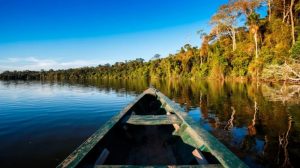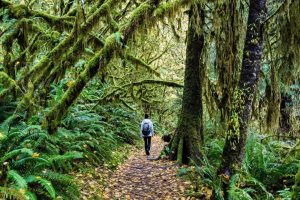
Embark on a green adventure as we delve into the world of sustainable travel in the rainforest. Get ready for practical tips, eco-friendly gear, and responsible exploration!
Sustainable Travel in the Rainforest
When it comes to traveling in the rainforest, sustainability is a crucial aspect to consider. Sustainable travel focuses on minimizing the negative impact on the environment, supporting local communities, and preserving the natural beauty and biodiversity of the rainforest for future generations.
Why Sustainability is Crucial in Rainforest Travel
Sustainability is essential in rainforest travel to protect the delicate ecosystem and prevent deforestation, habitat destruction, and species extinction. By practicing sustainable travel, we can help preserve the rainforest’s biodiversity and ensure its long-term survival.
Examples of Sustainable Practices for Rainforest Exploration
- Choose eco-friendly accommodations that prioritize sustainability and conservation efforts.
- Support local communities by purchasing locally-made products and hiring local guides.
- Respect wildlife by observing from a distance and not feeding or touching animals.
- Minimize waste by using reusable water bottles, avoiding single-use plastics, and properly disposing of trash.
- Follow designated trails to avoid damaging vegetation and disturbing wildlife habitats.
Packing Tips for Rainforest Travel

When preparing for a sustainable trip to the rainforest, packing efficiently and thoughtfully is key to reduce your impact on the environment. Here are some essential tips for packing light yet effectively for your rainforest adventure.
Essential Items for a Sustainable Rainforest Trip
- Reusable water bottle: Opt for a durable, BPA-free water bottle to stay hydrated without creating plastic waste.
- Eco-friendly toiletries: Choose biodegradable soaps, shampoos, and insect repellents to minimize harm to the environment.
- Solar-powered charger: Keep your electronics charged using solar energy instead of disposable batteries.
- Lightweight and quick-drying clothing: Pack breathable, moisture-wicking fabrics that dry quickly to stay comfortable in the humid rainforest.
- Reusable bags: Bring along reusable bags for shopping or carrying items to reduce single-use plastic waste.
Packing Light Yet Efficiently for the Rainforest
- Choose versatile clothing: Pack items that can be layered for varying weather conditions and activities to minimize the number of clothing pieces.
- Limit unnecessary items: Avoid overpacking by sticking to the essentials and leaving behind items you can do without.
- Opt for lightweight gear: Select lightweight and compact gear to reduce the weight of your backpack and make it easier to navigate through the rainforest.
Eco-Friendly Gear Choices for the Trip
- Reusable utensils: Carry a set of reusable utensils made from sustainable materials like bamboo or stainless steel to reduce single-use plastic waste.
- Sustainable footwear: Choose hiking boots or shoes made from eco-friendly materials and designed for the terrain of the rainforest.
- Biodegradable sunscreen: Protect your skin from the sun with biodegradable sunscreen that is safe for aquatic life in the rainforest.
Transportation in the Rainforest
When traveling in the rainforest, choosing the right mode of transportation is crucial for minimizing your environmental impact and promoting sustainability. Eco-friendly transportation options not only reduce emissions but also help preserve the delicate ecosystem of the rainforest.
Eco-Friendly Transportation Options
- Walking or Hiking: Opting to explore the rainforest on foot is one of the most sustainable ways to travel. It allows you to immerse yourself in nature while minimizing your carbon footprint.
- Bicycles: Cycling through the rainforest can be a great way to reduce emissions and enjoy the scenery at a leisurely pace. Make sure to choose designated cycling paths to avoid damaging the vegetation.
- Electric Vehicles: If motorized transportation is necessary, consider using electric vehicles that produce fewer emissions compared to traditional gasoline-powered vehicles.
Comparing Environmental Impact
- Boats vs. Cars: In the rainforest, traveling by boat is often more environmentally friendly than driving a car. Boats have lower carbon emissions and can navigate through waterways without disrupting the surrounding wildlife.
- Public Transportation vs. Private Vehicles: Opting for public transportation such as buses or shared vans can significantly reduce the overall carbon footprint of your journey compared to using private vehicles.
Tips for Choosing Sustainable Transportation
- Research and Plan Ahead: Look for eco-friendly transportation options in advance and choose companies that prioritize sustainability in their operations.
- Support Local Initiatives: Consider supporting local community-run transportation services that contribute to the conservation of the rainforest and provide economic benefits to the residents.
- Offset Your Carbon Footprint: If you must use carbon-intensive transportation, consider offsetting your emissions by investing in carbon offset programs or supporting reforestation projects.
Accommodation Choices in the Rainforest
When traveling to the rainforest, it is crucial to consider your accommodation choices to minimize environmental impact and support local communities.
Importance of Choosing Eco-Friendly Accommodations
- Reduce carbon footprint: Eco-friendly accommodations often use renewable energy sources and implement practices to reduce energy consumption, helping to minimize carbon emissions.
- Preserve biodiversity: By choosing eco-friendly lodges or hotels, you are supporting establishments that prioritize the protection of the surrounding ecosystem and wildlife.
- Support local communities: Eco-friendly accommodations tend to hire locally, invest in community projects, and promote cultural exchange, contributing to the economic development of the region.
Sustainable Accommodation Options in Rainforest Regions
- Eco-lodges: These accommodations are designed to have minimal impact on the environment, using sustainable materials, and implementing eco-friendly practices.
- Community-based tourism initiatives: Staying with local communities or in homestays can provide an authentic cultural experience while directly benefiting the residents.
- Treehouses and ecolodges: For a unique experience, consider staying in a treehouse or ecolodge that is constructed with minimal impact on the surrounding rainforest.
Tips on Supporting Local Communities through Accommodation Choices
- Choose accommodations that are owned and operated by local communities or employ local staff to ensure that your tourism dollars directly benefit the people living in the area.
- Participate in community-led activities or tours offered by your accommodation to learn more about the local culture and support community initiatives.
- Respect local customs and traditions during your stay to foster positive relationships with the community and contribute to sustainable tourism practices.
Leave No Trace Principles in the Rainforest
Traveling sustainably in the rainforest involves adhering to the Leave No Trace principles to minimize your impact on the delicate ecosystem. These principles are crucial to preserving the biodiversity and natural beauty of the rainforest for future generations.
Minimize Campfire Impact
When camping in the rainforest, it’s important to follow these guidelines:
- Use a camp stove instead of starting a fire to reduce the risk of wildfires.
- Avoid building new fire rings and instead utilize existing fire pits.
- Completely extinguish fires before leaving the campsite.
Dispose of Waste Properly
Responsible waste management is crucial in the rainforest to prevent pollution and harm to wildlife. Here’s how you can minimize your impact:
- Pack out all your trash, including food scraps and biodegradable waste.
- Avoid leaving any litter behind, as it can harm animals and disrupt the ecosystem.
- Use designated waste disposal areas or facilities if available.
Respect Wildlife
Interacting with wildlife in the rainforest should be done with caution and respect. Follow these guidelines:
- Observe animals from a safe distance and avoid feeding them.
- Avoid disturbing or approaching nesting sites and dens.
- Do not touch or handle wildlife, as it can stress or harm them.
Stay on Designated Trails
Trails in the rainforest are designed to minimize impact on the environment. Here’s how you can help:
- Stick to marked trails to avoid trampling vegetation and disturbing wildlife.
- Avoid creating new paths or shortcuts that can damage the ecosystem.
- Follow any guidelines or regulations set by park authorities for trail use.
Safety Precautions for Rainforest Exploration
When venturing into the rainforest, it’s crucial to prioritize safety to ensure a memorable and secure experience. Understanding potential hazards, staying prepared, and respecting the environment are essential for a successful rainforest exploration.
Potential Hazards in the Rainforest and Mitigation Strategies
Exploring the rainforest comes with its own set of risks, including wildlife encounters, unpredictable weather, and navigation challenges. Here are some tips to mitigate these hazards:
- Always stay on marked trails and avoid wandering off the designated paths to prevent getting lost.
- Carry a first aid kit, sufficient water, and food supplies to stay hydrated and nourished throughout your journey.
- Be aware of venomous snakes, insects, and plants; learn to identify them and maintain a safe distance.
- Respect wildlife by observing from a distance and refraining from feeding or attempting to touch animals.
Tips for Staying Safe in Remote Rainforest Areas
When exploring remote rainforest areas, it’s essential to take extra precautions to ensure your safety. Here are some tips to consider:
- Inform someone about your travel plans and expected return time before heading into isolated areas.
- Pack a reliable communication device, such as a satellite phone or personal locator beacon, for emergencies.
- Research the local wildlife and potential dangers in the area to prepare adequately for any encounters.
- Avoid swimming in unfamiliar bodies of water to prevent accidents or encounters with dangerous creatures.
Respecting Wildlife and Local Cultures in the Rainforest
While exploring the rainforest, it’s crucial to respect the biodiversity and cultural heritage of the region. Here are some ways to show respect during your travels:
- Do not disturb or remove plants, animals, or artifacts from their natural habitat to preserve the ecosystem’s balance.
- Follow local customs and guidelines when interacting with indigenous communities to show cultural sensitivity and respect.
- Avoid making loud noises, littering, or engaging in disruptive behavior that may harm the environment or disturb wildlife.
- Educate yourself about the local traditions, beliefs, and conservation efforts to appreciate and support the region’s unique heritage.
Mountain Travel

Exploring mountainous regions can be a rewarding experience, but it’s essential to practice sustainable travel to minimize environmental impact and preserve these delicate ecosystems.
Sustainable Practices for Mountain Travel
- Avoid littering and always pack out what you pack in to keep the mountains clean and pristine.
- Stick to designated trails to prevent soil erosion and damage to vegetation.
- Respect wildlife by observing from a distance and not feeding them.
- Choose eco-friendly transportation options like hiking, biking, or public transit to reduce carbon emissions.
Tips for Reducing Environmental Impact
- Use reusable water bottles and containers to minimize waste.
- Opt for energy-efficient accommodations or camping gear to lower your carbon footprint.
- Support local businesses and communities by buying locally sourced products.
Eco-Friendly Activities for Mountain Travelers
- Participate in clean-up initiatives to help maintain the cleanliness of mountain trails.
- Join guided tours led by local experts who prioritize conservation and sustainable practices.
- Engage in responsible wildlife watching activities that promote conservation efforts.
Desert Travel
Traveling sustainably in the desert is crucial to preserving the fragile ecosystem and minimizing the impact on the environment. Desert environments are unique and delicate, facing challenges such as limited water sources and extreme temperatures. Here are some important considerations for sustainable desert travel:
Importance of Sustainability in Desert Travel
- Reduce carbon footprint by choosing eco-friendly transportation options like public transport or carpooling.
- Stay on designated trails to avoid damaging sensitive desert vegetation.
- Respect wildlife by observing from a distance and not disturbing their natural habitat.
Water Conservation Strategies for Travelers in Desert Environments
- Carry a reusable water bottle and refill it at designated stations to reduce plastic waste.
- Take short showers and turn off taps when not in use to conserve water in accommodations.
- Avoid wasting water by using biodegradable wet wipes for personal hygiene instead of showering daily.
Tips on Minimizing Waste and Preserving Desert Ecosystems
- Pack reusable containers for snacks and meals to avoid single-use plastics in the desert.
- Properly dispose of waste in designated bins and carry out any trash to leave no trace in the desert.
- Avoid using disposable items like paper plates and plastic utensils to reduce waste generation.
Arctic & Polar Travel
Traveling sustainably in Arctic and polar regions presents unique challenges due to the fragile ecosystems and extreme weather conditions. It is crucial to minimize our impact on these delicate environments while exploring these beautiful but vulnerable areas.
Sustainable Travel Practices in Arctic and Polar Regions
When traveling to the Arctic or polar regions, it is essential to follow sustainable practices to protect the environment. Some key practices include:
- Avoiding single-use plastics and bringing reusable water bottles and bags
- Respecting wildlife and keeping a safe distance to minimize disturbance
- Choosing eco-friendly accommodations that prioritize environmental conservation
- Participating in local conservation efforts or community-based tourism initiatives
Unique Environmental Challenges of Traveling to Cold Regions
Arctic and polar regions face specific environmental challenges due to climate change and human impact. Some of these challenges include:
- Melting ice caps and shrinking glaciers affecting wildlife habitats
- Potential oil spills or pollution from increased shipping activities
- Threats to indigenous communities and their traditional ways of life
Eco-Friendly Transportation Options for Arctic Exploration
Exploring the Arctic sustainably involves choosing transportation options that minimize carbon emissions and environmental impact. Some eco-friendly transportation options for Arctic exploration include:
- Electric or hybrid vehicles for land transportation
- Small expedition ships with advanced waste management systems for sea travel
- Using snowmobiles or dog sleds for short-distance travel in remote areas
Jungle & Rainforest Travel
Traveling sustainably in the jungle and rainforest requires a deep understanding of these unique ecosystems and the importance of conservation efforts. By choosing eco-friendly practices and supporting local communities, visitors can help protect these vital environments for future generations.
Biodiversity in Different Rainforest Regions
- Rainforests are home to an incredible array of plant and animal species, with each region boasting its own unique biodiversity.
- The Amazon Rainforest in South America is the largest and most biodiverse rainforest in the world, while the Congo Basin in Africa and the rainforests of Southeast Asia also harbor rich ecosystems.
- Conservation efforts are crucial in all these regions to protect endangered species and preserve the delicate balance of these ecosystems.
Indigenous Communities and Sustainable Tourism
- Indigenous communities have inhabited rainforest regions for generations, possessing valuable knowledge of the land and its resources.
- By involving indigenous peoples in sustainable tourism initiatives, their cultural heritage can be preserved, and local economies can benefit from responsible travel practices.
- Supporting indigenous-led ecotourism projects can create a positive impact on both the environment and the livelihoods of local communities.
Coastal & Beach Travel
When it comes to coastal and beach travel, there are unique sustainability challenges that need to be addressed in order to protect these delicate ecosystems. Travelers can play a crucial role in preserving marine environments by adopting responsible practices and making conscious choices during their beach vacations.
Sustainability Challenges and Solutions
Coastal and beach destinations often face threats from pollution, overdevelopment, and irresponsible tourist behavior. To combat these challenges, travelers can support eco-friendly accommodations, participate in beach clean-up initiatives, and choose sustainable tour operators that prioritize conservation efforts.
Protecting Marine Ecosystems
- Avoid stepping on coral reefs or disturbing marine life while snorkeling or diving.
- Use reef-safe sunscreen to prevent harmful chemicals from damaging coral reefs.
- Dispose of trash properly and participate in beach clean-up activities to prevent litter from entering the ocean.
- Respect marine wildlife by keeping a safe distance and never feeding or touching them.
Responsible Beach Activities
- Participate in organized beach clean-ups to help remove plastic and debris from the shore.
- Support local conservation initiatives and marine protected areas by donating or volunteering.
- Choose water sports operators that follow sustainable practices and prioritize wildlife protection.
- Opt for eco-friendly activities such as kayaking, paddleboarding, or birdwatching to minimize impact on the environment.
Outcome Summary
As we wrap up our journey through sustainable rainforest travel, remember to leave only footprints and take away unforgettable memories of your eco-conscious escapades. Happy trails!
FAQ Insights
How can I ensure my rainforest trip is sustainable?
Choose eco-friendly accommodations, pack light, follow Leave No Trace principles, and respect local communities and wildlife.
What are some essential items to pack for a rainforest adventure?
Include insect repellent, quick-dry clothing, reusable water bottles, and biodegradable toiletries in your packing list.
How can I reduce my environmental impact while traveling in the rainforest?
Opt for eco-friendly transportation, minimize waste, and support local communities through sustainable accommodation choices.
What are some safety tips for exploring remote rainforest areas?
Stay on marked trails, carry emergency supplies, inform someone of your itinerary, and respect wildlife from a safe distance.





